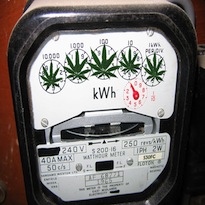 If you know an electrician or someone you can trust then you can have them set up your indoor or marijuana electrical system. Also, if you don’t, then you may need to know and understand the basics of marijuana electricity, and learning the basics will save you money, time, and possibly your life.
If you know an electrician or someone you can trust then you can have them set up your indoor or marijuana electrical system. Also, if you don’t, then you may need to know and understand the basics of marijuana electricity, and learning the basics will save you money, time, and possibly your life.
It is always a good idea to work backward when dealing with marijuana electricity. Start from the bulbs then go to the lamp and the ballast to where you will plug in when you are connecting them.
We will cover the many definitions of terms that are used in electrical work so knowing this can help you when you are working on electricity.
- Ampere (amp): The measure of electricity in motion. When electrical current flows at one coulomb per second, it is referred to as one ampere. Determining amperage is quite simple and can be found using Ohm’s law. I=V/R. Where “I” is amps, “V” is volts, and “R” is resistance.
- Breaker Switch: The ON/OFF safety switch that will turn electricity OFF when the circuit is overloaded. These switches are located in the breaker panel/box in your house or apartment.
- Circuit: The circular path that electricity travels. If the path of electricity is interrupted, the power will shut off, if it is allowed, it can go through your body.
- Conductor: Anything that can carry electricity easily, such as copper, steel, water, your body, etc.
- Fuse: An electrical safety device consisting of a fusible metal that melts and interrupts the circuit when overloaded.
- Grounding: Connect electricity to the ground or earth for safety so the marijuana electricity does not go where it shouldn’t and is sent to the ground to be rendered harmless since electricity will travel the path of least resistance.
- GFI or Ground Fault Interrupt: Outlets that are required, by electrical code, anywhere water is used in a home or business to shut down in cases of contact with water.
- Hertz: The irregular fluctuations or cycles in electricity within a conductor (wire). In the United States, these cycles run at 60 hertz (Hz), or cycles, per second.
- Ohm’s Power Law: A law that expresses the strength of an electric current: volts x amperes = watts (this law can be manipulated, to find volts, amps, and watts).
- Short Circuit: A short or unintentional circuit formed when conductors (wires) cross. A short circuit will blow fuses and turn off breaker switches.
- Volts: Electricity is under pressure or electrical potential. This pressure is measured in volts. Most home wiring is under the pressure of either 120 or 240 volts.
- Watts: A measure of work. Watts measure the amount of electricity flowing in a wire and when amperes, (units of electricity per second) are multiplied by volts (pressure), we get watts, 1000 watts = 1 kilowatt. Example: 9.3 amperes x 120 volts = 1,116 watts.
- Watt-hours: Measure the number of watts that are used during an hour. One watt-hour is equal to one watt used for one hour; a kilowatt-hour (kWh) is 1,000 watt-hours.
Electrical wires come in many different thicknesses (gauges) and are indicated by the number. Higher numbers indicate smaller wires while lower numbers indicate larger wire sizes.
Household Circuits & Outlets
 Most household circuits are 14-gauge wire that delivers electricity to outlets and household lights so wire thickness is important for two reasons, ampacity and voltage drop. An ampacity is the number of amperes a wire can carry safely without overheating.
Most household circuits are 14-gauge wire that delivers electricity to outlets and household lights so wire thickness is important for two reasons, ampacity and voltage drop. An ampacity is the number of amperes a wire can carry safely without overheating.
Voltage moves the electrical charge through the wire and wires that are 14-gauge are for 120-volt applications while the 18-gauge wire is for 240-volt applications. If you have a light that requires 120 volts to work, but only receives 90% (108 volts) of it due to a small wire gauge then it will only produce 70 percent of the normal light.
The same would go with a light that requires 240 volts to work, but only receives 90% (216 volts) so it produces only 70 percent of the light. When you are wiring a socket to the wall, the steps to take are as follows…
- Hot wires attach to brass or gold screw.
- Common wires attached to aluminum or silver screw.
- Ground wire (copper or green) attaches to the ground prong (usually green).
- Keep wires from crossing and forming a short circuit.
- Plugs and outlets must have a solid connection.
Be sure to always use the right size wiring and electrical cables for your equipment to get maximum performance and efficiency.
Let us know what you think.




Responses